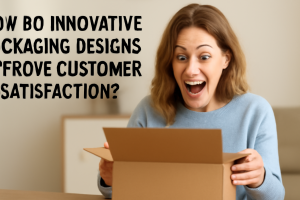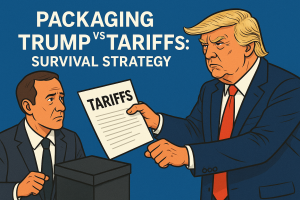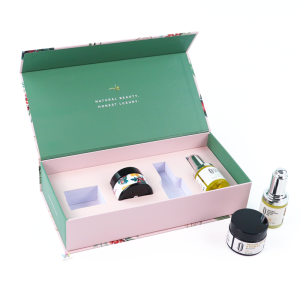When deciding between custom or stock packaging, businesses are faced with important choices that directly affect their branding, costs, and customer engagement. So, what’s the real difference? In this article, we’ll break down these two options, compare their benefits, and help you understand which one best suits your needs.
1. What is Custom Packaging?
Custom packaging is all about personalization. Here’s the deal: It allows businesses to design their own packaging to align with their brand, make a statement, and deliver an exceptional customer experience. Custom packaging goes beyond basic functionality, allowing for unique shapes, colors, materials, and prints.
● Overview of Custom Packaging Solutions
Custom packaging offers businesses a chance to fully tailor their packaging to their specific needs. Whether it’s product boxes, bags, or specialty wrapping, everything is designed to align with the brand’s identity and messaging.
● Types of Custom Packaging Solutions
There’s a broad range of custom options available, from luxury rigid boxes for high-end products to custom corrugated boxes for e-commerce. What’s the real story? The choice is dependent on your product type and target audience.
● Benefits of Custom Packaging
Not only does custom packaging help businesses stand out on store shelves or online platforms, but it also boosts the overall brand experience. When customers receive a product in beautifully designed packaging, it leaves a lasting impression. This leads to better brand recall and a stronger connection with the product.
● Real-Life Examples of Businesses Using Custom Packaging
Companies like Apple and Tiffany’s are prime examples of how custom packaging builds brand identity and enhances the unboxing experience. These companies use packaging to reinforce their premium quality and create excitement around their products.
2. What is Stock Packaging?
Stock packaging refers to pre-made, standardized packaging that’s ready to use. Ready for the good part? It’s designed for businesses that need packaging quickly and at a lower cost. Stock packaging doesn’t offer much customization, but it meets basic needs for a wide variety of products.
● Definition and Basic Concept of Stock Packaging
Stock packaging is made in large volumes and is often mass-produced. It’s readily available and usually comes in standard sizes and designs. It’s a great option for businesses with products that don’t require personalized packaging or special branding.
● Common Types of Stock Packaging Available
There are many types of stock packaging: corrugated boxes, poly bags, paperboard boxes, and more. This is where it gets interesting… The availability of pre-made options makes it quick and easy for businesses to get their products to market.
● When and Why Businesses Use Stock Packaging
If a company’s products don’t require a distinctive appearance or if they’re looking to save costs on packaging, stock packaging is the ideal choice. It’s a practical solution that can accommodate a wide range of product types at a fraction of the cost of custom packaging.
3. Why Should You Choose Custom Packaging Over Stock?
What’s the real story? Custom packaging offers a wealth of benefits for businesses looking to elevate their brand. Here’s why it’s worth considering: Custom packaging allows your products to stand out, conveys your brand’s message, and creates an emotional connection with your customers.
● Customization Flexibility and Brand Identity
With custom packaging, businesses have complete control over the design. This gives them a chance to create a unique look that reflects their brand personality, setting them apart from competitors. It’s not just about looks; it’s about delivering a cohesive brand experience across all touchpoints.
● How It Enhances Customer Experience
Imagine receiving a product in a beautifully designed package. Custom packaging adds value to the overall customer experience, making it memorable and exciting. This can lead to positive word-of-mouth and repeat purchases.
● Examples of Custom Packaging Boosting Business Success
Many small businesses, such as subscription boxes and artisanal brands, have seen significant growth by using custom packaging to deliver personalized, high-quality experiences. For example, Birchbox, a beauty subscription service, uses custom packaging to enhance the unboxing experience, helping them build a loyal customer base.
4. Why Stock Packaging Might Be the Better Choice
Here’s the kicker: Stock packaging is a practical, budget-friendly option that works well for businesses needing efficiency and affordability.
● Cost-Effectiveness of Stock Packaging
One of the biggest advantages of stock packaging is its affordability. Mass-produced options significantly reduce costs, especially when bought in bulk. For businesses with limited resources or those selling products with a low price point, stock packaging is an ideal solution.
● Quick Availability and Convenience
Stock packaging is readily available, making it perfect for businesses with urgent packaging needs. Unlike custom packaging, which requires design and production time, stock packaging is typically in stock and ready to ship.
● Ideal Businesses for Stock Packaging Solutions
Stock packaging works well for businesses selling high-volume, low-variation products like food, everyday household goods, and certain e-commerce items. If your products don’t require a unique design, stock packaging can help get your products to market quickly.
5. How Do Custom and Stock Packaging Affect Your Business’s Image?
Both custom and stock packaging affect your business’s image, but in different ways. This might surprise you: while custom packaging helps create a premium brand perception, stock packaging can convey a more practical, no-frills image.
● The Impact of Custom Packaging on Brand Perception
Custom packaging strengthens brand identity and positions your business as high-quality and customer-focused. The design communicates your values and enhances the overall experience.
● Stock Packaging’s Role in Product Presentation
Stock packaging, on the other hand, can be more generic. However, it still serves the important function of protecting the product and making it ready for sale. While stock packaging may not offer the same level of brand impact, it’s sufficient for many businesses.
● Case Study: Comparing Brands with Custom and Stock Packaging
For instance, Apple’s iconic product packaging exudes elegance and exclusivity. On the flip side, companies like Walmart use simple stock packaging, focusing on functionality rather than flair. Both strategies are effective, but the choice depends on the brand’s positioning.
6. Which Option Is More Cost-Effective?
Cost-effectiveness is often the deciding factor for businesses choosing between custom and stock packaging. Here’s the breakdown: stock packaging is cheaper, while custom packaging involves more upfront costs but can lead to better long-term gains.
● Comparison of Costs: Custom vs. Stock Packaging
Custom packaging tends to be more expensive due to design, materials, and production. However, stock packaging offers savings, especially for businesses with large orders.
● Hidden Costs in Both Options
With custom packaging, you may encounter higher shipping costs, especially for large, bulky boxes. On the other hand, stock packaging can involve costs tied to storage and inventory management.
● Choosing the Right Option Based on Your Business’s Budget
If you’re a small business or just starting out, stock packaging may be the best route. However, if you’re looking to build a strong brand identity, investing in custom packaging could pay off in the long run.
7. How Does Custom Packaging Improve Customer Engagement?
Ready for the good part? Custom packaging plays a huge role in customer engagement. It’s not just about looking good—it’s about creating an experience that customers want to share and remember.
● Psychological Effects of Custom Packaging on Customers
Studies show that customers are more likely to share their positive experiences with beautifully packaged products on social media. This enhances the brand’s visibility and fosters a deeper emotional connection.
● Building Loyalty Through Packaging
When customers feel that a product has been thoughtfully packaged, they’re more likely to trust the brand and return for future purchases. Custom packaging strengthens brand loyalty and increases customer retention.
● Custom Packaging’s Role in Repeat Sales
A memorable unboxing experience can directly influence future buying decisions. Brands like Amazon and small businesses that use unique packaging tend to see better customer retention due to positive packaging experiences.
8. How Does Stock Packaging Save Time?
This is where it gets interesting: Stock packaging can be a huge time-saver, especially for businesses that prioritize speed and efficiency. With stock packaging, businesses don’t need to worry about design or production times, allowing them to focus on other areas like product development or marketing.
● Faster Production and Shipment with Stock Packaging
Stock packaging is already manufactured and ready for use, which means businesses can quickly package their products and ship them out. This is ideal for businesses with high turnover and tight deadlines.
● Time-Saving Benefits for Businesses with High-Turnover Products
For companies that sell mass-produced goods, stock packaging eliminates the wait for custom design and production, ensuring that they can meet market demand efficiently.
● When Time Is a Priority: Stock Packaging as the Choice
If your business deals with time-sensitive products like seasonal goods, perishable items, or fast-moving consumer goods, stock packaging is a quick and reliable option.
9. What Are the Environmental Considerations for Custom vs. Stock Packaging?
Here’s something to think about: sustainability is a key factor in packaging decisions. Both custom and stock packaging come with environmental impacts, but there are ways to make each option more eco-friendly.
● Sustainability of Custom Packaging
Custom packaging offers the opportunity to choose eco-friendly materials and designs. Brands that focus on sustainability often choose biodegradable or recyclable materials for custom packaging, aligning their packaging with their environmental values.
● Stock Packaging and Environmental Impact
Stock packaging often involves mass production, which can lead to greater waste. However, some stock packaging options use recycled or recyclable materials, reducing their environmental footprint.
● Best Practices for Eco-Friendly Packaging Solutions
Brands that want to reduce their environmental impact can opt for stock packaging that’s made from recycled materials or custom packaging solutions that incorporate sustainable materials like cardboard, paper, or biodegradable plastics.
10. Can Custom Packaging Offer a Better ROI?
When considering packaging, businesses often ask, “Can this decision drive better profits?” The answer is yes—custom packaging can deliver higher returns on investment (ROI) if executed correctly.
● Measuring ROI with Custom Packaging
Custom packaging can lead to better customer engagement, repeat sales, and word-of-mouth marketing, all of which contribute to improved ROI. By elevating the customer experience, businesses can command higher prices and build stronger brand loyalty.
● Case Studies Showing ROI with Custom Packaging Solutions
Consider companies like Starbucks, whose custom cups and packaging help reinforce the brand’s premium image. These companies have seen increased sales and stronger customer retention as a result of their unique packaging.
● How Custom Packaging Aligns with Long-Term Business Goals
Custom packaging helps reinforce a brand’s identity, which contributes to long-term success. Brands that invest in their packaging are often seen as more professional, which can justify higher prices and attract a more loyal customer base.
11. How Does Custom and Stock Packaging Impact Shipping and Handling?
What’s the real story? Packaging choices can significantly impact shipping costs and logistics. Custom packaging might seem more elaborate, but it can actually help save costs when well-designed, while stock packaging offers simplicity in handling and shipping.
● Custom Packaging’s Effect on Shipping Cost
Custom packaging can be more expensive to ship, especially if the packaging is larger, bulkier, or requires special handling. However, if designed efficiently, custom packaging can reduce product damage during transport and even reduce the need for extra protective materials.
● Stock Packaging and Efficient Logistics
Stock packaging is generally easier to manage in terms of logistics. Pre-made, standardized packaging sizes make it easier to stack and ship efficiently. The lack of customization also makes it quicker to source and handle, reducing overall operational costs.
● Shipping Considerations When Choosing Between the Two
If your business prioritizes operational efficiency and cost reduction in shipping, stock packaging is often the most straightforward choice. On the other hand, if your brand benefits from premium presentation and customer experience, investing in custom packaging may be worth the added shipping cost.
12. What Are the Limitations of Stock Packaging?
While stock packaging can be a great solution for many businesses, it does come with its limitations. Here’s the catch: stock packaging is not always ideal when you need something unique or specific for your product.
● Restrictions on Design and Customization
Stock packaging comes in a limited range of styles, sizes, and materials. If your product doesn’t fit within these options, you might find it difficult to find the right packaging. The lack of customization can also be a drawback for brands trying to create a distinct visual identity.
● Size and Compatibility Limitations
Many stock packaging options are generic and may not perfectly fit your product, leading to wasted space or additional protection requirements. This can increase the overall cost of packaging and shipping.
● How Stock Packaging Can Affect Your Branding Message
If your business relies heavily on branding and visual appeal, stock packaging might not send the right message. Generic packaging can give customers the impression of a lower-quality product, which could hurt your brand image.
13. What Are the Limitations of Custom Packaging?
Custom packaging certainly offers many benefits, but it’s not without its challenges. Here’s what you need to consider: the higher upfront costs and time investments can make custom packaging less appealing for some businesses.
● Higher Upfront Costs
Custom packaging typically involves significant upfront costs for design, production, and setup. For small businesses or startups with tight budgets, this can be a major obstacle.
● Longer Lead Times for Production
Custom packaging often requires longer production times. This can delay your product launch and may not be ideal if you’re working on a tight timeline.
● Complexity in Design and Logistics
Designing custom packaging can be complex, especially if your product requires special considerations. Additionally, custom packaging may require specialized logistics for transportation, increasing both the cost and time to market.
14. When Should You Use Custom Packaging?
Ready for the good part? Custom packaging is ideal when your business needs to create a unique brand experience. Here’s when it’s the right fit for your company:
● Best Scenarios for Custom Packaging
Custom packaging works best for businesses with high-end or luxury products that require a premium presentation. It’s also great for companies that want to create a distinctive unboxing experience for their customers.
● Types of Products That Benefit Most from Custom Packaging
Products like cosmetics, electronics, or artisanal goods often benefit from custom packaging because they rely on premium aesthetics and need to stand out.
● How to Identify When Your Business Needs Custom Packaging
If you have a product that tells a story, fits a luxury market, or needs to be presented uniquely, custom packaging is likely the right solution. It’s also great for businesses that want to invest in long-term branding.
15. When Should You Use Stock Packaging?
Sometimes, stock packaging is the way to go. What’s the real story here? Stock packaging is an excellent solution when you need a fast, affordable, and reliable option.
● Ideal Situations for Stock Packaging
Stock packaging is perfect for businesses with a high volume of products that don’t require unique or personalized packaging. It’s also a great choice for startups or businesses on a budget.
● Budget Constraints and Product Types Suited for Stock Packaging
If your product is standard and doesn’t need a unique look, stock packaging is a great option. Think of items like food products, basic clothing, and everyday consumer goods.
● How to Decide if Stock Packaging Meets Your Business Needs
If you need packaging in a hurry, don’t have a large marketing budget, or sell products that don’t need special presentation, stock packaging is likely the right choice.
FAQ Section
Q1: What are the differences between custom and stock packaging?
Answer: Custom packaging offers tailored designs, while stock packaging is mass-produced and standardized. Custom packaging is often used for branding, while stock packaging is chosen for its cost-effectiveness and availability.Q2: Is custom packaging more expensive than stock packaging?
Answer: Yes, custom packaging usually involves higher upfront costs due to design and production, but it can offer long-term benefits in terms of customer engagement and brand identity.Q3: When should a business choose stock packaging?
Answer: Stock packaging is ideal when businesses need cost-effective solutions with quick turnaround times for products that don’t require a unique design or branding.Q4: Can custom packaging improve my ROI?
Answer: Yes, custom packaging can lead to better ROI by enhancing customer experience, increasing brand recognition, and boosting sales through improved product presentation.Q5: How do I choose between custom and stock packaging for my products?
Answer: Consider your budget, product type, and branding needs. If your product requires a distinctive look or is part of a premium brand, custom packaging might be the best choice. For high-volume, low-cost products, stock packaging is ideal.
Conclusion
Both custom and stock packaging offer unique benefits, but the best option depends on your business needs, budget, and branding strategy. Custom packaging allows for a distinctive brand presence, while stock packaging offers efficiency and cost savings. Ultimately, the choice is yours.




